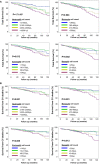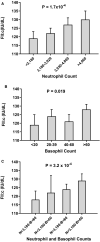Basophil Blood Cell Count Is Associated With Enhanced Factor II Plasma Coagulant Activity and Increased Risk of Mortality in Patients With Stable Coronary Artery Disease: Not Only Neutrophils as Prognostic Marker in Ischemic Heart Disease
- PMID: 33624506
- PMCID: PMC8174269
- DOI: 10.1161/JAHA.120.018243
Basophil Blood Cell Count Is Associated With Enhanced Factor II Plasma Coagulant Activity and Increased Risk of Mortality in Patients With Stable Coronary Artery Disease: Not Only Neutrophils as Prognostic Marker in Ischemic Heart Disease
Abstract
Background White blood cell count, which is inexpensive and widely available in clinical practice, has been proposed to provide prognostic information in coronary artery disease (CAD). Elevated levels of white blood cell subtypes may play different roles in atherothrombosis and predict cardiovascular outcomes. Methods and Results The association between white blood cell counts and mortality was evaluated in 823 subjects with angiographically demonstrated and clinically stable CAD in an observational-longitudinal study. The correlation among white blood cell counts and factor II plasma coagulant activity was analyzed in 750 subjects (554 CAD and 196 CAD-free) not taking anticoagulant drugs. Subjects with overt leukocytosis or leukopenia were excluded. In the longitudinal study after a median follow-up of 61 months, 160 (19.4%) subjects died, 107 (13.0%) of whom from cardiovascular causes. High levels of neutrophils, monocytes, eosinophils, and basophils were associated with an increased mortality rate. In multiadjusted Cox regression models, only neutrophils and basophils remained predictors of total and cardiovascular mortality. The associations remained significant after adjustment for traditional cardiovascular risk factors and by including D-dimer and the chemokine CXCL12 in the regression models. Neutrophils and basophils were also significant predictors of factor II plasma coagulant activity variability after adjustment for blood cell counts, age, sex, inflammatory markers, CAD diagnosis, and prothrombin G20210A polymorphism. Factor II plasma coagulant activity was similarly increased in subjects with high neutrophil and basophil counts and in carriers of the prothrombin 20210A allele. Conclusions Both high neutrophil and basophil blood counts may predict mortality in patients with clinically stable CAD and are associated with enhanced factor II plasma coagulant activity, thereby suggesting underlying prothrombotic mechanisms.
Keywords: basophils; factor II plasma coagulant activity; neutrophils; secondary prevention of coronary artery disease; white blood cell count.
Conflict of interest statement
None.
Figures




References
Publication types
MeSH terms
Substances
LinkOut - more resources
Full Text Sources
Other Literature Sources
Medical
Miscellaneous

